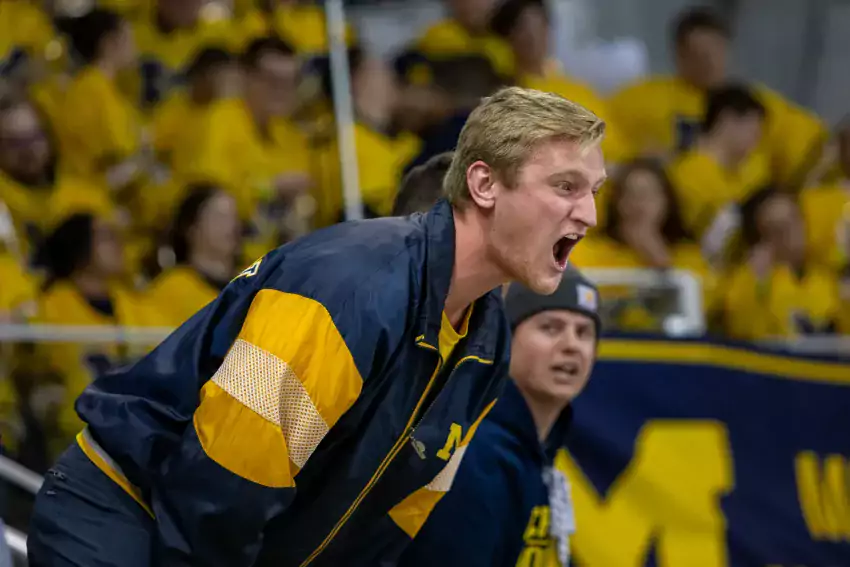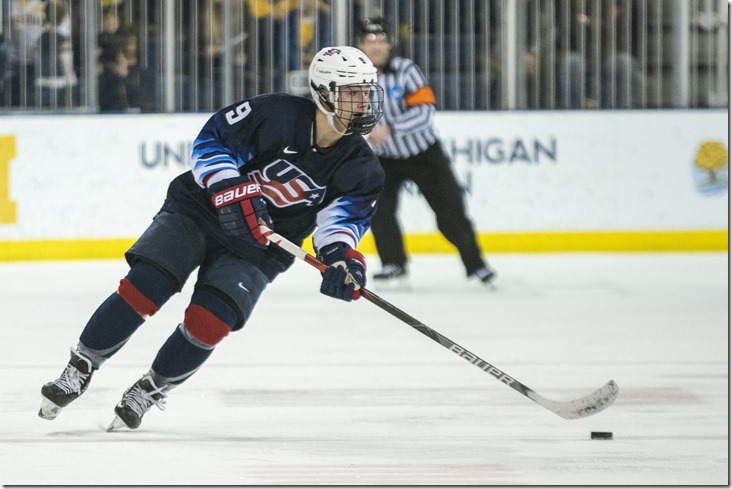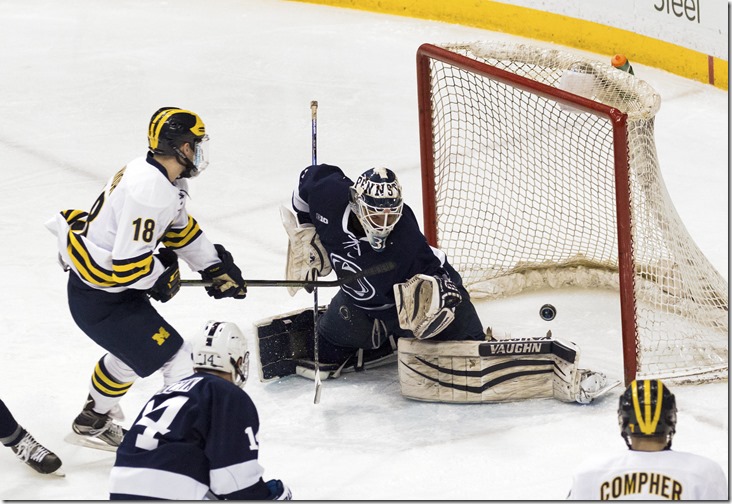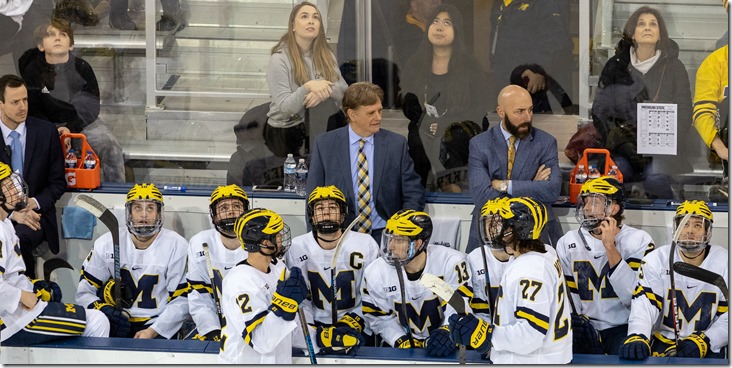
A Guide To College Hockey Recruiting Acronyms

A couple of commenters responded to the annual hockey recruiting rundown posts by gesturing at the thicket of acronyms and doing that one gif with the mullet guy, so here's an explainer about the alphabet soup that is junior hockey.
First, a general timeline:
- 14 and 15 year-olds on midget teams get noticed at various tournaments and are recruited by colleges. New legislation means they can't commit yet; historically a bunch have gone off the board very early. Now they have to wait. In practice this means that commits will be silent until August two years before their enrollment.
- High-end prospects spend their junior and senior years of high school—approximately—in a junior league like the USHL or BCHL before heading to college.
- Lower tier prospects will spend up to two more years in junior before landing somewhere.
The following items are not in alphabetical article to prevent redundancy.
[After THE JUMP: now you can tell your AJHL from your NTDP!]
CSB. The Central Scouting Bureau. The NHL has a department that issues public rankings for draft-year players. It's unclear why the NHL issues draft rankings at all—googling turned up no interest in the topic aside from a Wikipedia article noting that it was established in 1975 to "establish a centralized database of NHL prospects." Maybe back in 1975 it was hard to figure out who was actually a viable NHL prospect in the Czech Republic or whatever.
The CSB issues separate lists for North American and European players. Goalies in each geographical area are split into their own lists, as well. So if you're translating CSB ranking into draft projections you should probably multiply a North American skater's ranking by 1.5. (EG, a player ranked 30th is actually being projected in the middle of the second round once you add in Euros and the odd goalie.)
The CSB issues three rankings annually. The preliminary one groups players into A, B, and C bands representing potential first-, mid-, and late-round picks. The midterm and final ones are ranked 1 to ~250.
D, D-1, D-2. D is short for draft. A "D" year is the year before you get drafted. Quinn Hughes spent his D year at Michigan. A D-1 year is the year before that. You get the idea.
Thomas Bordeleau is one of many NTDP players to play at Yost before enrolling [James Coller]
NTDP. The National Team Development Program. USA Hockey collects the ~best 23 players in the country annually and houses them in Plymouth for a two-year period. The first year there are a bunch of international tournaments and games against the USHL. The second year there are a ton of international tournaments, about a half-season of college exhibitions, and more USHL games.
By any standard the NTDP has been a wild success. The US's performance in youth international tournaments has improved radically since the NTDP's inception, and the program does an excellent job of shielding the US's top talent from the CHL until it's time to enroll in college. Prior to the NTDP's existence (and the USHL's emergence) elite college-bound prospects had an awkward period where they'd be playing in league worse than Major Junior right before they got drafted.
With the new rules college commitments are going to happen after the U17 NTDP is named, which is going to be a feeding frenzy.
At a minimum any NTDP commit projects as a productive college player, and usually the top guys in any particular recruiting class will be coming from the program. Any time you see an "NTDP" next to a Michigan recruit's name that's a win.
Kyle Connor is a USHL alum and first round pick [Patrick Barron]
USHL. The only "tier A" junior circuit in the US. USA Hockey set a bunch of standards for junior leagues to make; the USHL made them and separated itself from various other circuits to become college hockey's #1 feeder league. Level of play is in the ballpark of Major Junior if you lend credence to point equivalencies. Take Andrei Svechnikov, the #2 pick in 2018. Svechnikov spent a year in the USHL with Muskegon before spending his draft year in the OHL. The results:
- Muskegon, D-1: 29-29-58 in 48 games, 1.2 PPG
- Barrie, D: 40-32-72 in 44 games, 1.6 PPG
That's pretty much what you'd expect from a high level NHL draft pick who didn't switch leagues. Another comparison point: the previous year's #2 overall pick, Nolan Patrick, spent his junior career in the WHL. In his D-1 he put up 1.4 PPG with the Brandon Wheat Kings—who I bring up mostly because they compete with the BCHL's Trail Smoke Eaters for the best-named team in junior hockey.
Anyway, the USHL is a good junior league that has become the main feeder for college hockey teams. Age is important when evaluating USHL players, because there's a vast difference between a 16 year old and a 20 year old. There are guys who score like Svechnikov every year, but if they're already 19 or 20 that means a lot less. See Emil Ohrvall, who transferred away from RPI after a year, put up 63 points in 59 USHL games as a 20 year old and then had 4 once he went back to college.
(Yes, it is a common thing for NCAA transfers to spend their sit-out year back in junior.)
NAHL. Once a near-equivalent of the USHL, now clearly second tier. NAHL players fill out the lower rungs of college hockey, with most teams sending their players to a mix of D3 and lower-level D1 teams.
Michigan players claimed as NAHL alumni generally had a cup of coffee in the league before hopping up to the USHL or a Canadian junior league. Jack Summers and Keaton Pehrson had less than a season in the league; Garrett Van Whye spent one year there and then two in the USHL before arriving.
Players coming directly from the NAHL to Big Ten teams are likely to be fourth-liners or healthy scratches. During the 2019-20 season, the only two Michigan players to come directly from the NAHL were Jack Olmstead and Adam Winborg. Winborg was a senior, Olmstead a sophomore; they combined to play in six games.
Goalies are an exception, because goalies can come from anywhere.
Bill Muckalt (standing on the right with murderbeard) is a BCHL alum [JD Scott]
BCHL/AJHL/OJHL/etc. These are, confusingly, "Junior A" circuits. They are the Canadian equivalents of the USHL and feed a ton of players into college hockey. They are somewhere between the USHL and NAHL in terms of quality. Where depends on the league. These leagues have a smattering of high end guys who happen to be Canadians who want to play college, and then a second tier of solid college-level players, and then a murky bottom. BC == British Columbia. A == Alberta. O == Ontario. There is also a Saskatchewan one but it is bereft.
Age is everything when evaluating recruits coming out of these leagues, even more than the USHL. They feature buckets of goals and wildly varying players, with everything from future NHL first rounders to guys who wouldn't stand out on beer league teams on the same ice. A guy like Kent Johnson putting up 100 points in his D-2 year is a dude. A 19 year old on the same pace might be a scoring line player. Might be.
Note that the OJHL, once a place that shepherded Andrew Cogliano through his last couple years before he arrived in Ann Arbor, hasn't sent a recruit to Michigan in pretty much forever. I don't know what the impetus is for that, but it seems like high end Ontario guys who want to play in college are going to the USHL in larger numbers.
High schools. Minnesota has high quality high school hockey that is another major NCAA feeder, though these days an increasing number of them are getting picked off by the USHL. There are also toity prep circuits on the East Coast that produce the occasional draft pick and a ton of Hockey East recruits.
Michigan does not dip into these areas much. An exception is Shattuck St. Mary's, a Minnesota prep school that annually houses some of the top prospects in the country before the USHL or NTDP comes calling. Michigan will get Shattuck players semi-regularly.
CHL: The Canadian Hockey League. AKA "Major Junior." A mostly Canada-based amateur circuit that is the traditional route for Canadian players to get to the NHL. More draft picks than college hockey but has an age range of 16-20; the average age of a college team is around 22.
OHL/WHL/QMJHL. The CHL is divided into three leagues based on geography. The QMJHL is generally regarded as the weakest of the three and rarely has much impact on Michigan's recruiting. The WHL ranges from Vancouver to Winnipeg and Michigan will occasionally go head to head for a team in that league for a recruit out of Western Canada or California. This figures to be relevant going forward since Bill Muckalt is from British Columbia and Michigan has been active in its acquisition of commits out West.
The OHL, though. Ever since MSU went in the dumpster you could make a credible case that Michigan's chief hockey rival is the OHL. The list of Michigan commits (and "commits") who have defected is long and somewhat painful. The OHL draft has annually been a pins-and-needles affair for Michigan hockey recruitniks, who brace whenever London is on the clock.
The role of the OHL draft is about to change, though: soon it will be an indicator of who will be part of the August commit feeding frenzy instead of a way for guys to manipulate their landing spots at the cost of some internet nerd heartstrings.
Midget/Bantam. These are the first levels of hockey where it's possible to be a prospect. Generally these players will be 3-4 years away from college and playing on sponsored travel teams. All top prospects in the state of Michigan will be on these teams.
Midget stats are erratic and sometimes impossible to get, and at that level guys can flame out spectacularly when they try to transition up. It's not particularly important to know the details since they're all at about the same level, but if someone is talking about "Little Caesars," "Honeybaked," "Oakland Grizzlies," or "Chicago Mission" they're talking about a midget team.
Chris Heisenberg. Heisenberg maintains a comprehensive list of college recruits. He's done that for 20+ years, long before there was anyone else attempting the same.
Great recap, Brian - very insightful! Just wanted to call out one point regarding the comment that the "QMJHL is generally regarded as the weakest of the three." Having grown up in Canada and having played hockey at various levels, I think it's important to clarify that while the QMJHL may be regarded as being overall weaker, it's more than that. While this league has produced talented players like Mario Lemieux & Pat LaFontaine, it is generally regarded as a finesse league that, again generally speaking, emphasizes skill & finesse over physical play, when, say compared to the OHL. I'd say it's more like comparing the Big 12 & Pac-10/12 to the B1G in football - Spread offense vs. man-ball. Again, a generalization, but you get the point. In the OHL, one of the first things you better learn how to do is play physical & defend yourself. In the QMJHL, the first thing you better be able to do is go top shelf & score goals.
That's good info as well. It is too bad that LaFontaine lost so much time to concussions and injury. He was a fun player to watch when healthy.
Played against Pat & his brother when we were teenagers. You could see he was going to be good, but was still one of the smallest players on the ice back then.
April 16th, 2020 at 11:12 PM ^
Correct
Thanks Brian for the clarification of hockey recruitment. I've attended a couple of NAHL games while visiting my daughter in Texas. The Lone Star Brahmas play in the Ft. Worth area. Always on the must do list whenever we go down there.??
April 17th, 2020 at 11:30 AM ^
That's awesome to hear. They're the old Texas Tornado who I once had a tryout with. Glad to see they're still around in some form; they dominated the NAHL back in the Tornado days.
Holy hell I needed this. I really like College hockey, but was completely in the dark as to how 'recruiting' worked and all the different leagues and what not.. Thanks Brian
He didn’t really mention it in this article, but it’s been brought up a few times before and I think it’s important to note it.
Hockey recruiting is done so far in advance that despite Mel being here three full seasons already, this incoming class is the first class you can truly say is HIS class. Pretty much everyone that’s come in during his tenure so far has been either a late addition or recruited by Berenson.
So a lot of people try to blame Mel for the talent void we currently have, but it’s really not on him at all. He’s actually done a phenomenal job on the recruiting trail and the next couple classes are absolutely loaded.
Hockey recruiting classes are generally 100% completed 2-3 years in advance, and the remainder of that time is spent hoping they don’t go to a CHL team (this becoming ineligible for NCAA hockey as CHL is designated as a pro league) and determining which year a specific player will be brought in based on roster attrition. For example, an early NHL entry or a CHL defection could bump a kid we were letting sit in juniors an extra year or two into college sooner. A high draft pick staying an extra year in college could conversely keep a recruit in juniors an additional year.
Overall VERY confusing if you don’t pay close attention to the process.
Here for the mullet guy gif.
My first professional sportswriting gig was covering Midget and Bantam for Michigan Hockey Magazine, the rag they give away free at rinks that most people pick up because everyone's kid's name gets in it eventually. The guys who are going to play in college stand out immediately Midget. They're twice as fast as the other players, and they spend the whole game shouting at teammates to not be such artards.
April 16th, 2020 at 11:41 PM ^
back in my day it was just the jr. wings, little ceasars, paddock pools, the redford royals and the fraser highlanders. we played in canada in tournaments of course. the nat'l championship was in NY. man, that was so long ago.
April 17th, 2020 at 12:33 PM ^
I’m not even that old (26) and even from my midget years (which i guess was about 10 years ago, maybe I am old) it was Belle Tire, Little Caesars, Honeybaked, Victory Honda, Compuware, Chicago Mission and Chicago Young Americans. That was THE AAA league in the midwestern US. Anything else was subpar. Now I see the teams are in different leagues and there’s now Oakland Grizzlies and a Meijer team and more.
Wait, Brian reads the comments? Kidding! Keep up the good work B!
Double post
April 20th, 2020 at 11:04 AM ^
Thanks. This is indeed helpful and a ton of good information.
I often get frustrated when it is assumed that people know acronyms. I guess the idea is, unless it is an acronym that "everyone knows," you're supposed to spell out the acronym the first time you use it in a written piece. That leads to two questions: 1) who decides what "everyone" knows? and 2) should you consider a site like MGoBlog in its entirety or have each article include stuff written out?
The reason I bring up the point is that, in an article about explaining acronyms, Brian starts using undefined acronyms about half way through (see: USHL and NAHL in the article). I was good until QMJHL and I still had no idea what the hell *that* is until I googled it.
All annoying comments aside... again: Thanks for all the insight.
The Trail Smoke Eaters - Jeff Tambellini was their GM the last two seasons - used to play in the KIJHL (Kootenay International Junior Hockey League), which has some of the best names in all of organized hockey. (Take that, Grizzly Adams Wolfsburg!)
Fernie Ghostriders
Creston Valley Thunder Cats
Kimberley Dynamiters
Golden Rockets
100 Mile House Wranglers
Chase Heat



Comments